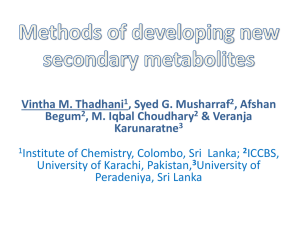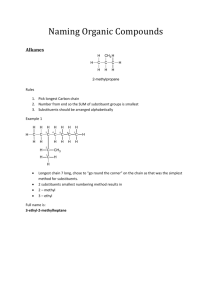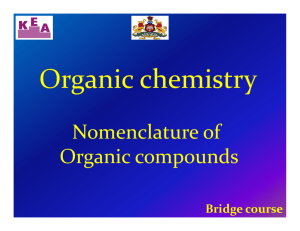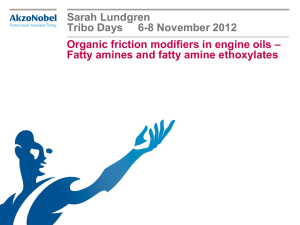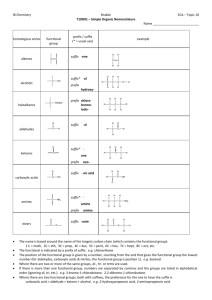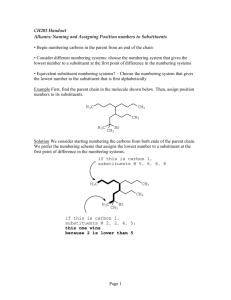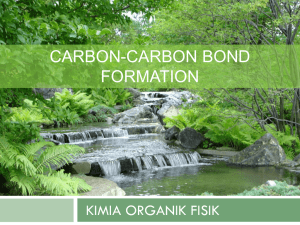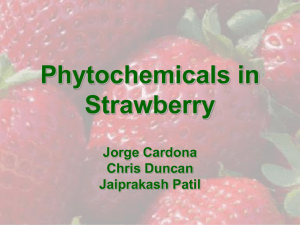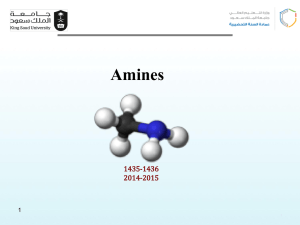Organic Chemistry
advertisement
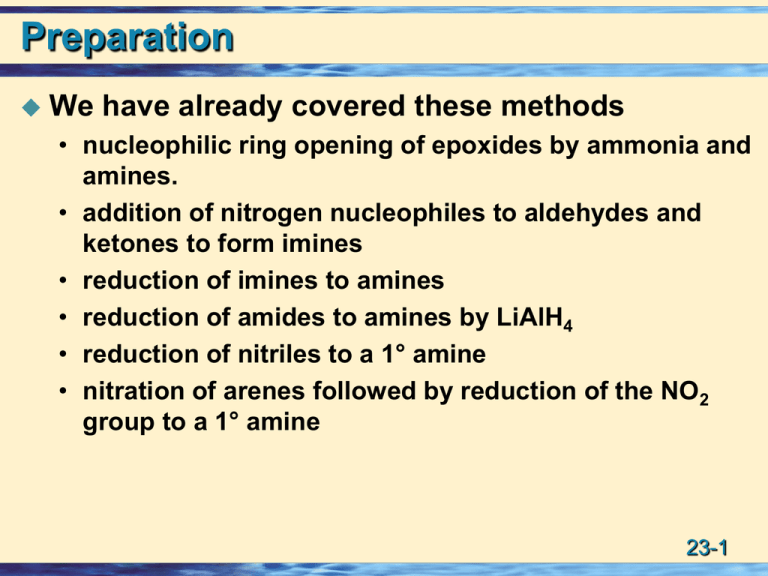
Preparation We have already covered these methods • nucleophilic ring opening of epoxides by ammonia and amines. • addition of nitrogen nucleophiles to aldehydes and ketones to form imines • reduction of imines to amines • reduction of amides to amines by LiAlH4 • reduction of nitriles to a 1° amine • nitration of arenes followed by reduction of the NO2 group to a 1° amine 23-1 Preparation Alkylation of ammonia and amines by SN2 substitution. SN 2 + N H CH3 Br 3 CH3 NH 3 + Br Me th yl am mon i um bromi de • Unfortunately, such alkylations give mixtures of products through a series of proton transfer and nucleophilic substitution reactions. CH3 Br + NH3 + - + - CH3 NH3 Br + (CH3 ) 2 NH2 Br + - + + (CH3 ) 3 NH Br + (CH3 ) 4 N Br polyalkylations 23-2 - Preparation via Azides Alkylation Ph CH2 Cl Benzyl chloride K N3 - RN 3 R N + N : N: - Az ide i on (a good n u cle oph il e ) + : N + N : -: : N3 - of azide ion. N: - An al k yl az i de 1. LiAlH4 Ph CH2 N3 2. H2 O Benzyl azide Ph CH2 NH2 Benzylamine Overall Alkyl Halide Alkyl amine 23-3 Example: Preparation via Azides • Alkylation of azide ion. A rCO 3 H Cycl oh e xe n e O 1. K + N3 - 2 . H2 O 1,2-Epoxycycl oh e xan e OH 1 . LiA lH4 2 . H2 O N3 trans- 2-Az i docycl oh e xan ol (racem ic) OH N H2 trans- 2-Am in ocycl oh e xan ol (racem ic) Note retention of configuration, trans trans 23-4 Reaction with HNO2 Nitrous acid, a weak acid, is most commonly prepared by treating NaNO2 with aqueous H2SO4 or HCl. HNO2 + H2 O In H3 O+ + NO2 - pK a = 3.37 its reactions with amines, nitrous acid: • Participates in proton-transfer reactions. • A source of the nitrosyl cation, NO+, a weak electrophile. 23-5 Reaction with HNO2 NO+ is formed in the following way. • Step 1: Protonation of HONO. • Step 2: Loss of H2O. H + + H O N O (1) + H O N O (2) H H O + H + N O + N O Th e n itros yl cation • We study the reactions of HNO2 with 1°, 2°, and 3° aliphatic and aromatic amines. 23-6 Tertiary Amines with HNO2 • 3° Aliphatic amines, whether water-soluble or waterinsoluble, are protonated to form water-soluble salts. • 3° Aromatic amines: NO+ is a weak electrophile and participates in Electrophilic Aromatic Substitution. Me2 N 1. NaNO2 , HCl, 0-5°C 2. NaOH, H2 O N,N-Dimethylaniline Me2 N N=O N,N-Dimethyl-4-nitrosoaniline 23-7 Secondary Amines with HNO2 • 2° Aliphatic and aromatic amines react with NO+ to give N-nitrosamines. N-H + HNO2 Piperidin e N-N=O + H2 O N-N itrosopiperidin e carcinogens 23-8 Amines with HNO2 Reaction of a 2° amine to give an N-nitrosamine. • Step 1: Reaction of the 2° amine (a nucleophile) with the nitrosyl cation (an electrophile). • Step 2: Proton transfer. • • + • • •• + N O (1) + N N •• N N=O • • N=O • • •• • • •• •• • • H H + + H O H H •• (2) • • H O H 23-9 RNH2 with HNO2 1° aliphatic amines give a mixture of unrearranged and rearranged substitution and elimination products, all of which are produced by way of a diazonium ion and its loss of N2 to give a carbocation. Diazonium ion: An RN2+ or ArN2+ ion 23-10 1° RNH2 with HNO2 Formation of a diazonium ion. Step 1: Reaction of a 1° amine with the nitrosyl cation. : An N-n itros ami n e : : : : : : : + R-NH2 + : N O : A 1° al iph ati c am in e : k e to-e n ol tau tome ri s m H R-N-N=O : R-N=N-O-H A di azotic acid Step 2: Protonation followed by loss of water. : : : : R-N=N-O-H H + •• R-N A di azotic acid •• N •• A di azon i u m i on + R + N •• N •• •• R + N H + - H2 O O-H N A carbocation 23-11 1° RNH2 with HNO2 Aliphatic diazonium ions are unstable and lose N2 to give a carbocation which may: 1. Lose a proton to give an alkene. 2. React with a nucleophile to give a substitution product. 3. Rearrange and then react by Steps 1 and/or 2. Cl (5.2%) OH N H2 N aN O2 , H Cl 0-5o C OH + (25%) (13.2%) (25.9%) + (10.6%) 23-12 1° RNH2 with HNO2 reaction: Treatment of a aminoalcohol with HNO2 gives a ketone and N2. Tiffeneau-Demjanov OH CH2 NH2 + HNO2 A-aminoalcohol O + H2 O + N2 Cycloheptan on e 23-13 Mechanism of Tiffeneau-Demjanov • Reaction with NO+ gives a diazonium ion. • Concerted loss of N2 and rearrangement followed by proton transfer gives the ketone. : : : O-H : OH CH2NH2 HNO 2 CH2 + N N: -N2 (A diazonium ion) : : : :O H + O H + CH2 CH2 A resonance-stabilized cation proton transfer to H2O O Cycloheptanone Similar to pinacol rearrangement 23-14 Pinacol Rearrangement: an example of stabilization of a carbocation by an adjacent lone pair. Overall: 23-15 Mechanism Reversible protonation. Elimination of water to yield tertiary carbocation. This is a protonated ketone! 1,2 rearrangement to yield resonance stabilized cation. Deprotonation. 23-16 1° ArNH2 with HNO2 -N2+ group of an arenediazonium salt can be replaced in a regioselective manner by these groups. The H2 O HBF4 HCl, CuCl Ar-NH2 HNO2 0-5°C Ar-N2 + (-N2 ) HBr, CuBr Ar-OH Ar-F Sch ieman n reaction Ar-Cl Ar-Br San dmeyer reaction KCN, CuCN Ar-CN KI Ar-I H3 PO2 Ar-H 23-17 1° ArNH2 with HNO2 A 1° aromatic amine converted to a phenol. OH NH2 Br Br 1 . HNO2 2 . H2 O, heat CH3 2-Bromo-4methylanilin e CH3 2-Bromo-4meth ylp henol 23-18 1° ArNH2 with HNO2 Problem: What reagents and experimental conditions will bring about this conversion? CH3 CH3 (1) COOH (2) N O2 COOH (3) N O2 COOH (4) N H2 OH 23-19 1° ArNH2 with HNO2 Problem: Show how to bring about each conversion. CH3 Cl (5) CH3 CH3 NH2 (6) CH3 C N (8) CH3 CH3 NH2 Cl CH2 NH2 (7) Cl (9) Cl Cl 23-20 Hofmann Elimination Hofmann elimination: Thermal decomposition of a quaternary ammonium hydroxide to give an alkene. • Step 1: Formation of a 4° ammonium hydroxide. CH3 I + CH2 -N - CH 3 + A g2 O H2 O CH3 (C ycl oh exylm e th yl)tri me th yl -Si lve r oxide amm oni u m iodide CH3 OH+ CH2 -N - CH 3 + A gI CH3 (C ycl oh exylm e th yl)tri me th yl ammon i u m h ydroxi de 23-21 Hofmann Elimination • Step 2: Thermal decomposition of the 4° ammonium hydroxide. CH3 OH+ CH2 -N - CH 3 160° CH3 (C ycl oh exyl me th yl )tri me thyl amm on i u m hydroxi de CH2 + Me th yl en e cycl ohe xan e ( CH3 ) 3 N + H2 O Trim eth ylami n e 23-22 Hofmann Elimination Hofmann elimination is regioselective - the major product is the least substituted alkene. CH3 + N(CH3 ) 3 OH heat - CH2 + (CH3 ) 3 N + H2 O rule: Any -elimination that occurs preferentially to give the least substituted alkene as the major product is said to follow Hofmann’s rule. Hofmann’s 23-23 Hofmann Elimination HO H H H C H CH 3 CH 2 C + N ( CH 3 ) 3 HOH E2 reaction (concerted elimination) H CH 3 CH 2 H C C H N ( CH3 ) 3 • The regioselectivity of Hofmann elimination is determined largely by steric factors, namely the bulk of the -NR3+ group. • Hydroxide ion preferentially approaches and removes the least hindered hydrogen and, thus, gives the least substituted alkene. • Bulky bases such as (CH3)3CO-K+ give largely Hofmann elimination with haloalkanes. 23-24 Cope Elimination Cope elimination: Thermal decomposition of an amine oxide. Step 1: Oxidation of a 3° amine gives an amine oxide. O + CH2 N-CH3 + H2 O2 CH3 - CH2 N-CH3 + H2 O CH3 An amin e oxid e Step 2: If the amine oxide has at least one -hydrogen, it undergoes thermal decomposition to give an alkene. O - H + 100-150°C CH2 N-CH3 CH3 CH2 Methylenecyclohexane + (CH3 ) 2 NOH N,N-Dimethylhydroxylamine 23-25 Cope Elimination • Cope elimination shows syn stereoselectivity but little or no regioselectivity. • Mechanism: a cyclic flow of electrons in a sixmembered transition state. C - CH3 C heat N+ :O CH3 Transition s tate : H C C H an alken e CH3 N O N,N-d imeth ylhydroxylamin e CH3 23-26
